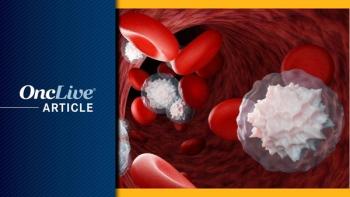
Zanidatamab Zovodotin Showcases Promising Safety, Activity in HER2+ Solid Cancers

Zanidatamab zovodotin was found to produce encouraging responses and to have a manageable toxicity profile when used as a monotherapy in heavily pretreated patients with HER2-positive solid cancers.
Zanidatamab zovodotin (ZW49) was found to produce encouraging responses and to have a manageable toxicity profile when used as a monotherapy in heavily pretreated patients with HER2-positive solid cancers, according to data from a first-in-human phase 1 trial (NCT03821233) presented during the 2022 ESMO Congress.
Among 29 patients, the HER2-targeting antibody-drug conjugate (ADC) elicited a confirmed objective response rate (cORR) of 31% (95% CI, 15.3%-50.8%), which included a partial response (PR) rate of 31% and a stable disease (SD) rate of 41%. Twenty-four percent of patients experienced disease progression (PD). The disease control rate (DCR) achieved with the ADC was 72% (95% CI, 52.8%-87.3%) and the clinical benefit rate (CBR) was 38% (95% CI, 20.7%-57.7%).
“The maximum tolerated dose [MTD] has not been reached. Two dose-limiting toxicities [in the form of] grade 2 keratitis were observed in 1 patient each at the 1.75 mg/kg weekly and 2.5 mg/kg every-3-week cohorts,” Komal Jhaveri, MD, FACP, section head of the Endocrine Therapy Research Program and clinical director of the Early Drug Development Service at Memorial Sloan Kettering Cancer Center, said in a presentation on the data. “No interstitial lung disease or pneumonitis were reported, [and] there were no treatment-related deaths.”
Zanidatamab zovodotin has an immunoglobulin 1–like antibody backbone that is directed against extracellular domain 4 and 2 of HER2, with an antibody sequence that is identical to that of zanidatamab (ZW25). The proprietary auristatin payload is covalently linked with a protease cleavable valine-citruline linker. The agent has an average drug-to-antibody ratio of 2.
Investigators launched the first-in-human, dose-escalation and -expansion trial to further evaluate zanidatamab zovodotin’s safety and efficacy in patients with HER2-expressing or -amplified solid cancers.
To be eligible for enrollment, patients were required to have refractory disease and must have received trastuzumab (Herceptin), pertuzumab (Perjeta), and fam-trastuzumab emtansine (T-DM1; Kadcyla). They also needed to have an ECOG performance status of 0 or 1. Furthermore, those with HER2-positive gastroesophageal adenocarcinoma (GEA) were required to have received trastuzumab.
The trial had a 3+3 design, and patients received zanidatamab zovodotin weekly, as part of a 28-day treatment cycle, on a 3-weeks-on/3-weeks-off schedule; every 2 weeks, as part of a 28-day cycle; or every 3 weeks, as part of a 21-day cycle. The dose-expansion cohorts included those with HER2-positive breast cancer, HER2-positive GEA, and other HER2-positive solid cancers.
The primary objectives of the research were to identify the MTD and the recommended phase 2 dose (RP2D) of zanidatamab zovodotin, as well as to characterize the safety and tolerability of the agent. Examining the antitumor activity of the ADC in those with HER2-expressing cancers served as a key secondary objective.
As of June 9, 2022, a total of 77 patients received treatment with the ADC across the dose-escalation portion of the trial, as well as in the dose-expansion portion. Those in the expansion portion of the research were given zanidatamab zovodotin at 2.5 mg/kg every 3 weeks. Of these patients, 12% (n = 9) continue to receive the ADC.
In the total population, the median age was 59 years (range, 24-83), 58% were female, 57% were White, and 66% had an ECOG performance status of 1. Regarding primary diagnosis, 27% had GEA, 22% had breast cancer, and 51% had other solid cancers. Other tumors included ovarian cancer, endometrial cancer, bladder cancer, biliary tract cancer, anal cancer, colorectal cancer, pancreatic cancer, and non–small cell lung cancer.
Regarding HER2 status, 58% of patients were IHC3+ and 16% were IHC2+/FISH+. Sixty-nine percent of patients previously received HER2-targeted therapies, and the median number of previous systemic regimens received in the metastatic setting was 3 (range, 1-16).
Additional data showed that among the 8 patients with breast cancer, zanidatamab zovodotin induced a cORR of 13% (95% CI, 0.3%-52.7%), which included a PR rate of 13% and a SD rate of 38%; 38% of patients experienced PD. The DCR in these patients was 50% (95% CI, 15.7%-84.3%), and the CBR was 25% (95% CI, 3.2%-65.1%).
In the 11 patients with GEA, the cORR achieved with the ADC was 37% (95% CI, 10.9%-69.2%), which comprised a PR rate of 36% and a SD rate of 36%; 27% experienced PD. In this group, the DCR and CBR were 73% (95% CI, 39.0%-94.0%) and 36% (95% CI, 10.9%-69.2%), respectively.
In the remaining 10 patients with other solid cancers, zanidatamab zovodotin elicited a cORR of 40% (95% CI, 12.2%-73.8%), which included a PR rate of 40% and a SD rate of 50%; 10% of patients had PD. Here, the DCR was 90% (95% CI, 55.5%-99.7%) and the CBR was 50% (95% CI, 18.7%-81.3%).
In those who received zanidatamab zovodotin at 2.5 mg/kg every 3 weeks in both portions of the trial (n = 30), 90% of patients experienced any-grade treatment-related adverse effects (TRAEs). The most common TRAEs experienced with the ADC were keratitis (43%), alopecia (17%), and diarrhea (30%). All keratitis effects decreased to grade 1 in severity or resolved; there was mandatory ocular prophylaxis.
Grade 3 or higher TRAEs were experienced by 17% of patients, with 3% experiencing grade 3 or higher keratitis. Treatment-related serious AEs were experienced by 7% of patients, with 3% experiencing infusion-related reactions, and 3% experiencing electrocardiogram QT prolongation.
“Dose reduction was required in 21% of patients due to TRAEs, [which included] 19% of those in the dose-escalation [portion of the research] and 24% of patients in the dose-escalation [portion],” the study authors concluded. “These patients continued receiving zanidatamab zovodotin at a reduced dose level.”
Reference
Jahveri K, Han HS, Dotan E, et al. Preliminary results from a phase 1 study using the bispecific, Human Epidermal Growth Factor 2 (HER2)-targeting antibody-drug conjugate (ADC) zanidatamab zovodotin (ZW49) in solid cancers. 2022;33(suppl 7):S749-S750. doi:10.1016/j.annonc.2022.07.589

























































































